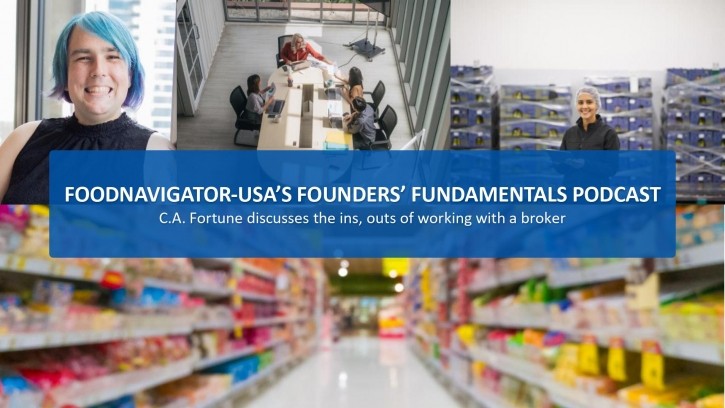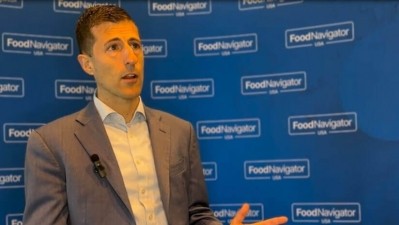[Podcast] Founders’ Fundamentals: C.A. Fortune shares tips for selecting the perfect broker

In the second episode of the Founder’s Fundamentals podcast, Meagen Arensdorff, VP of C.A. Build, and Alissa Monteleone, director of business development and C.A. Consult, discuss how founders and startups can find the right broker partner and ways brands can expand their retail footprint, in an interview with FoodNavigator-USA’s senior correspondent Ryan Daily.
[Editor’s note: Did you miss the first episode of FoodNavigator-USA’s new podcast series, Founders’ Fundamental? Then, click here to revisit our conversation with iced tea veteran Seth Goldman.]
Growing in retail: ‘The spaghetti-on-the-wall technique does not work anymore’
Brokerage firms, like C.A. Fortune, help startups secure retail shelf space, manage sales paperwork and optimize packaging and prices to succeed, they shared.
When selecting a broker, startups first should have a concrete sales strategy and understand where they want to grow and in what channel, which can determine if brands go with a smaller, more regionally focused broker or a national one, Arensdorff explained.
“You start with your own sales strategy and how you as a brand want to scale and grow within the US market. And so that is really thinking about the different channels that your product may be able to thrive in, whether that is the convenience channel, the grocery channel [or] natural channel — really understanding where do you want to scale — and doing your homework about the type of brokers that are out there and where they have access and relationships and what tools and capabilities can they bring to the partnership to best support your growth,” she added.
When it comes to growing a retail footprint, brands should focus on a specific channel or retailers and understand the limits of their resources, growing smartly and strategically and with a broker that understands those limits, Monteleone explained.
“This spaghetti-on-the-wall technique does not work. It is too expensive, and the resources absolutely have to be thoughtfully delegated, or unfortunately, you are going to run out,” she emphasized.
‘Velocities matter:’ How pack size, promotion can help or hurt a startup
Startups must carefully consider the size of their product and how many they put in a case, as well as how they drive consumers into stores through promotions and discounts, the two explained.
While a brand might want to fill a case with as much product as possible to save on shipping costs, it might slow down restocking and velocities — the rate at which a product is sold — Monteleone cautioned. Most retailers require brands to give the retailer a free case of product — what is called a “free fill” — to sell their product, so a brand can save money by not overfilling a case, she added.
“Velocities matter. We tell folks all the time that it is going to cost you to get on the shelf, you are going to make money getting off the shelf ... through rotation. What we want is for that buyer to be able to replenish you on a regular basis. If you have 24 in case, it is going to take much longer than if you have our ideal number, which is six to eight,” Monteleone elaborated.
CPG brands also need a concrete pricing and promotion strategy, as many retailers require brands to do some form of paid promotions, Arensdorff said. While traditional in-store discounts and promotions are one way to drive trials and boost velocities, brands also can tap into retailers’ ecommerce platforms and shopping apps to engage consumers digitally, Arensdorff noted.
“There are going to be expectations, whether it is at the distributor side or the retailer side in terms of promotions, and that you are supporting the partnership with them. On that front, it is just about being creative. Retailers coming out of COVID are really looking at all of their different marketing opportunities for brands, so it is no longer just the tag on shelf, which does matter. But there are loyalty programs, there are digital marketing opportunities [and] there are all these different ways in which you can really reach your consumer beyond just being in the store,” she added.


![[Podcast] Founders' Fundamentals: Greenwich Capital Group on negotiating everything from slotting fees to successful exits](/var/wrbm_gb_food_pharma/storage/images/_aliases/wrbm_medium/publications/food-beverage-nutrition/foodnavigator-usa.com/news/brands-manufacturers/podcast-founders-fundamentals-greenwich-capital-group-on-negotiating-everything-from-slotting-fees-to-successful-exits/17661778-1-eng-GB/Podcast-Founders-Fundamentals-Greenwich-Capital-Group-on-negotiating-everything-from-slotting-fees-to-successful-exits.jpg)








